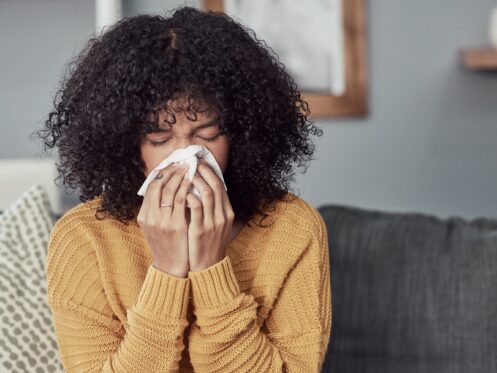The air inside your Victoria, BC, home should be comfortable and healthy. This is especially important since most of us spend a great deal of time indoors each day. Unfortunately, indoor air is often worse inside your home than it is outdoors. Do you know how to spot the effects of poor air quality in your home? Let’s discuss the signs and symptoms that present themselves, as well as what you can do to improve your IAQ.
What Impacts Indoor Air Quality?
Indoor air quality can be decreased by several factors. Pollution and pollen from outside can come indoors through your windows, doors and small gaps and cracks, leading to a high concentration of particulate matter inside. If you’re in an area that experiences wildfires, the smoke may come indoors and affect your IAQ.
There are several culprits inside your home that impact your IAQ. If you have pets, their dander and fur can cause an increase in allergies, asthma, etc. Allowing people to smoke in your home is unhealthy and can increase particulate matter in your indoor air.
Dust, dust mites, and mold spores can also decrease the safety of your indoor air quality. Volatile organic compounds are released from things like chemical cleaning products, air fresheners, new building materials such as carpet, countertops, and cupboards, as well as beauty products, detergents, etc.
Respiratory Problems
Inhaling particulate matter, fragrances, and other sources of indoor pollution can lead to inflammation, irritation, and constriction of your airways. This can lead to respiratory issues such as coughing, wheezing, a sore throat, or shortness of breath. If you have asthma or another chronic respiratory issue, you may see an increase in breathing issues when you have poor indoor air quality.
Allergy Symptoms
Allergy symptoms vary from one person to another but generally include things like coughing, sneezing, itchy skin, irritated eyes, and a runny nose. Constant exposure to indoor contaminants can make allergies worse by increasing your histamine load. This can make you more prone to having a reaction.
Headaches
Headaches can occur for all sorts of reasons, including fatigue, illness, and stress. However, chronic headaches are often associated with something you’re encountering on a regular basis. Your indoor air quality may be to blame. Headaches can be associated with allergies, but also mold exposure and exposure to VOCs.
Rashes and Other Skin Issues
Do you find yourself constantly itching your skin or breaking out into hives or rashes? It’s not necessarily something you’re eating or touching. When you breathe in poor indoor air, this can cause your body to react by producing more histamines or increasing inflammation. Your skin can become inflamed and irritated as your body deals with this increase in mast cell activity.
Dizziness
Dizziness can occur from exposure to mold, dust, and other indoor contaminants. It’s very common for people to feel dizzy when they are exposed to high levels of VOCs on an ongoing basis. These chemicals are very dangerous to our health, causing a disruption of hormones in the body, creating inflammation, and much more.
Odd Smells in Your Home
When you walk in the door, does your home smell musty or unpleasant? You may not be able to put your finger on one smell or the source of the smell, but you know that your home doesn’t smell fresh and inviting. This can be caused by several issues. If you have a lot of carpet in your home, carpet can hold on to dust, dust mites, mold spores, and odors. This can cause a distinct odor in your home that is hard to get rid of with regular cleaning processes. Your pets may also be contributing to the smell, as well as the fragrances and chemicals that are in many of our household products.
High Levels of Humidity
Poor indoor air quality can cause high levels of humidity in the home. When you don’t have a healthy exchange of air between your home and the outside, this can result in moisture building up from weather changes, bathing, cleaning, cooking, etc.
Condensation or Film on Surfaces
The high levels of humidity that we just mentioned can cause condensation to form on surfaces like windows, doors, mirrors, light fixtures, etc. You may also see an oily film on surfaces, which means there are particles in your air that are settling.
What Can Be Done?
Now that you know what to look for, you may be wondering how you can make adjustments to your home that will improve your indoor air quality. Luckily, there are several things you can do to make your home a healthier space. Professional heating maintenance and AC tune-ups are a good starting point, since poorly-maintained HVAC systems and dirty ducts will cycle more contaminants throughout your home. However, this is only the first step, and not a comprehensive solution.
Air Purification and Filtration
You may be aware of the portable air filters and purifiers that can be moved from one room to another. While they can be very effective at cleaning your indoor air, they tend to be unattractive and inconvenient. Our team can install whole-house purification equipment as part of your furnace. All the air circulating in your home will be filtered. Depending on the type of unit that you select, you can often remove as much as 99.97% of the particulate matter in your indoor air. This is accomplished with high-quality filters, such as high efficiency particulate air filters, or HEPA for short.
Activated carbon filters are another great option to consider. This material is sometimes used for furnace filters, but they are common in air purification devices. The activated carbon absorbs odors as well as volatile organic compounds, creating a fresher and healthier space. Just make sure that you’re not using an activated carbon filter in your furnace that is too restrictive for what your heating and cooling equipment can handle. This can cause too much strain on your system.
Consider increasing the amount of ventilation in your home. You likely already have exhaust fans in your bathrooms and kitchen. These should be run while you’re bathing and cooking to remove odors and particulate matter from your home. You can also have additional ventilation installed in attics and throughout your home if IAQ is a concern.
If you’re dealing with unhealthy levels of humidity in your home, a whole-house dehumidifier or humidifier can help. This equipment requires minimal maintenance when it’s installed on your HVAC system. It can help you bring interior humidity levels between 35% and 50%, which is what’s recommended for optimal indoor air quality.
If you are interested in learning more about the ways you can improve your indoor air quality, reach out to our team here at Darias Heating & Air Conditioning. We would be happy to perform an indoor air quality assessment to determine what your main IAQ culprits are. We can also install whole-house purification and ventilation equipment to improve the quality of your indoor air. We also install, service, and maintain different types of heating and cooling equipment. We can clean your ductwork as needed to improve IAQ as well.
Contact Darias Heating & Air Conditioning in Victoria to schedule an appointment today.


